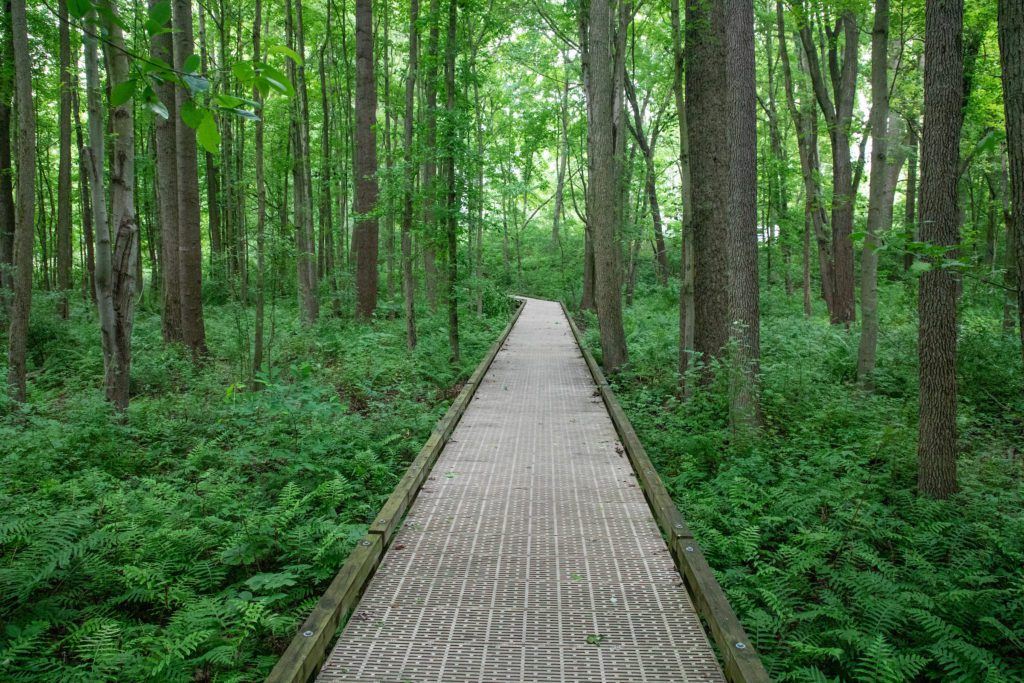
October 4, 2022
Imagine : you’re standing in a grove of tall lush trees. There’s a gentle breeze, the sun is shining and the forest is calm. What do you see? Smell? Hear? Feel? How does your body feel in this moment? If you’ve made it to the end of this paragraph, shinrin-yoku may be for you.
What is Shinrin-yoku?

Shinrin-yoku translates literally to ‘forest bathing’ or ‘absorbing the forest atmosphere’. The term was created by the Japanese Ministry of Agriculture, Forestry and Fisheries in the early 1980s, and – contrary to what you may be thinking – involves no actual bathing. Essentially, shinrin-yoku encourages people to spend time in nature while practicing mindfulness by remaining present in the moment and utilizing all five senses (sight, smell, taste, hearing and touch) throughout their experience.
In practice, this means taking intentional moments during your walk to notice the sounds of the forest – the birds, rustling of leaves, crunch of the soil; the smells you encounter – like peat, wildflowers, herbs or decaying leaves; the easily overlooked sights – the movement of trees, pattern of their bark or dabbling of color in the landscape; the touch sensations – the breeze on your skin, the texture of a leaf or fallen tree; and the taste of the forest – the taste of the air, or a foraged tea prepared at the end of your journey. By focusing on each of these senses, you remain grounded in the moment and notice far more about the world around you. But shinrin-yoku is far more than just a sensory walk in the woods – the practice has very real, measurable effects on human health.
Forest Bathing and the Human Body

Today, shinrin-yoku is a standard preventative care medical prescription for the Japanese public. In wide-ranging studies, practicing forest bathing has been shown to improve recovery from stress by lowering cortisol, improve attention, improve immune function, lower pulse rate and lower blood pressure. It has also been shown to reduce negative symptoms of people suffering with chronic depression. Generally, shinrin-yoku is practiced daily for short intervals of around 20 minutes to 1 hour, but can also be practiced weekly or monthly. Every bit counts!
Getting Started with Shinrin-yoku
Want to give shinrin-yoku a try? Head over to our trails page to pick your starting point. Silence your phone, take a few minutes before you start to quiet your mind. As you walk be intentional about noticing the world around you. If your mind begins to wander to everyday tasks or thoughts, let them pass and center yourself on the experience of being in the trees.
The concept is simple enough, but disconnecting from the world can be much harder in practice. Our daily concerns about that email we forgot, the dinner prep we need to do, the schedules and noise of every day life is difficult to tuck away for a 20-minute walk in the woods. While a guide isn’t required to practice shinrin-yoku, they are certainly helpful to keep your mind present in the moment and connect your senses with the world around your through specific activities.
Want to explore more about this topic? Check out some of the resources used to create this post below:
A Comparative Study of the Physiological and Psychological Effects of Forest Bathing (Shinrin-Yoku) on Working Age People with and Without Depressive Tendencies by Akemi Furuyashiki et al.
The Physiological Effects of Shinrin-yoku (Taking in the Forest Atmosphere or Forest Bathing): Evidence from Field Experiments in 24 Forests Across Japan by Bum Jin Park et al.
Forest Bathing: What it is and why you should try it
Shinrin-Yoku (Forest Bathing) and Nature Therapy: A State-of-the-Art Review by Margaret M. Hansen et al.


